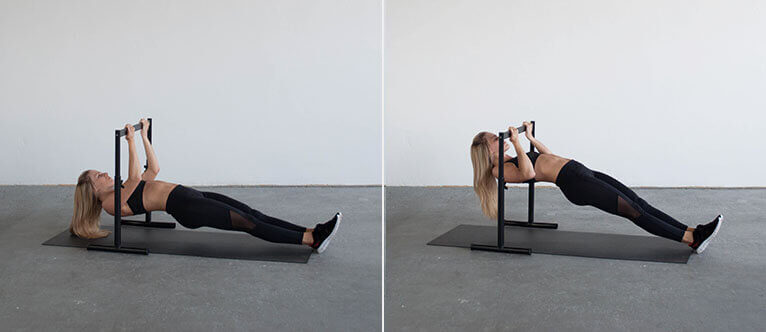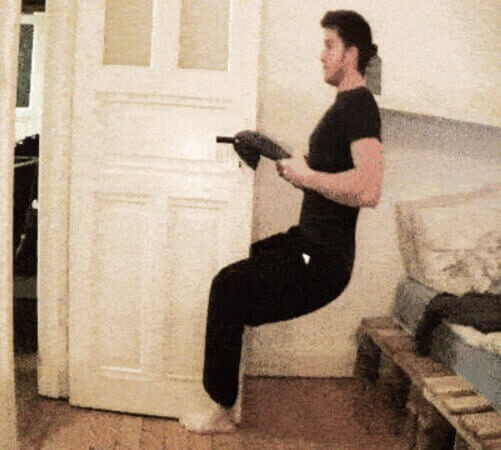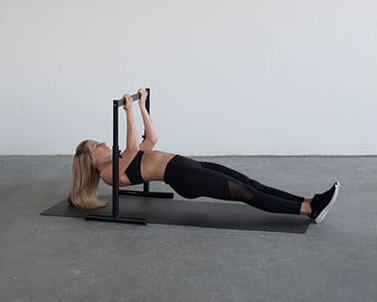The Australian pull up exercise or can be called the horizontal pull-ups both relatively is a similar exercise, it’s popularly and known to people as the standard pull-up or chin-up.
It is an alternative version and another upgrade to the standard pull-ups, which differ from the usual vertical pull-up in that the bar will be perpendicular to your shoulders.
But the Australian pull-up is very simple and effective while performing pull-ups, where you position yourself “under” the bar (in the horizontal position) to ensure that you are hitting more muscles, like the mid-back muscles from an angle that aren’t like a traditional pull-up exercise.
In this post, I will guide you how to do Australian pull-up exercises the right way! how to do it at home without equipment? The benefits of performing pull-ups, an overview of exercise alternatives and other variations, and the different handles that can be used during a workout that will hit accordingly a different upper body muscles.
The Australian Pull up Overview
The Australian pull-up is an upper body muscle building exercise that uses body weight to counteract gravity during your performance.
Here, when a person dangles below the bar with their torso and straight legs, which should be above waist height with heels touching directly on the floor, they will end up with their torso at a 45-degree angle to the floor, which will be roughly the same as the push-up position but upside down.
Once you reach this position, you can strengthen the body as you pull the chest forward on the bar. But keep in mind that you need to be very careful during the exercise, for example, make sure that you do not bend the hips or ignore the shrug of the shoulders, and once the chest is about two inches from the bar, make a short pause with attention to give more control in the lower back area.
This exercise has a completely different level of movement and works the muscles from different angles. These angles differ from the standard pull-ups or even chin-ups that hit a different, wider side of your muscles, which are located in the middle of the back, with the biceps, abs, as well as the upper back.
The horizontal or Australian pull-ups is well suited for a beginner workout level, Why! Because you can control how much weight you want to pull each time just by changing the incline level of your body, either lighter or heavier, and it’s a safer exercise since you don’t use actual weight, except to motion your body against gravity.
More information with a full description of the Australian Pull up process is provided below to ensure that you follow the full details of the exercise and the steps required to make it work.
Why is it called the Australian Pull up?
The exercise is called by this name, because the person who does the routine will be at the bottom of the bar and trying to pull the body towards it, and it is common in the country of Australia to practice some things or exercises that are upside down, in fact the official name of the exercise is called inverted rows, which is a push-up exercise Upside-down, but in an Australian style.
This exercise can be used easily to learn balance during exercise or while trying to build upper and middle muscles, increase their strength and improve their performance using traditional methods.
All you need is to select the equipment that can be used for the exercise and leave the rest. Barbell, squat stand, ring rows (but it’s more challenging), all these methods can be used to perform this pull-up exercise.
Australian Pull Up Exercise Step by Step

To perform the Australian pull-up, begin by locating the level of the horizontal bar (fixed position) and holding it at a height of 1.5 times the length of the arm above ground level, then start the following exercise step by step:
- Place your body under the bar, to be in a straight horizontal position, and make sure you have a soft blanket or a mat under you to rest your body.
- Next, extend the arms, with a firm and straight hand, and grab the bar with both hands with a supinated fist, at a distance of shoulder width, emphasizing the need to position the body correctly and making sure that the horizontal bar is at chest level.
- Keep the neck, head, torso, feet and legs tilted in one line by correct spinal alignment.
- Use the feet as a focal point. Make sure the feet are closed or extended according to the desired body stability. It is common and preferred to set a close feet.
- Then, while inhaling pull the body up towards the bar, until the chest touches the bar, your heels will be a fulcrum on the floor at a 45 degree angle.
- Next, lower the body down toward the starting position as you exhale.
- And that’s all. Simply repeat the steps for pulling the bar up and down five to six times for your daily routine.
Muscles that work in Australian pull up
There are many major and minor muscles that are worked out during the Australian pull-up exercise. The main load falls on the latissimus dorsi and biceps brachii, as well as other muscles that are involved if different grips are used during the exercise, the infraspinatus muscles located in the back of your shoulder, the trapezius muscles (for the reverse grip), the rhomboid muscles, teres major, brachialis and back spine.
The main muscles that work are the upper back, shoulders, and arms. Even abdominal muscles work to strengthen and sculpt the abdominal muscles better and maintain good posture. The rest of the other muscles contribute less.
Australian Pull Ups Benefits
There are many benefits associated with the Australian pull-up exercise which are:
- Improve your body posture
- Helps to strengthen and expand the muscles of Trapezius and Latissimus Dorsi
- Shoulder problems can be reduced by using this exercise
- It can build better and bigger biceps
- Improve grip strength and endurance
- Helps develop one gorgeous look
How to do Australian pull ups at Home?
Australian pull-ups can be easily performed at home. Being in the gym is not necessary, but it does require from you to be very careful while exercising to avoid chances of injury.
There are two ways to perform the exercise at home in the absence of a bar:
A) Before you begin, find a thick dowel made of a durable material such as metal or even wood. Just make sure the item chosen is strong enough to withstand your weight.
Once you find it, simply stick a dowel across the chairs or benches that will be a replacement for bar (be sure to keep a good height off the floor). Make sure the tape is sturdy, and before you exercise it would be a good idea to test it by pulling on it a little more forcefully.
This will ensure that you will not fall or get hurt by the dowel break or sliding during the exercise. Then simply follow the steps of the exercise movements above.
B) If plan A is hard to achieve, you can replace it with bringing a long towel or resistance band, then at the height of the doorknobs, twist/attach them to the door handles, keeping both ends hanging so you can grab them with both hands later.
Next step With the door with the straps on the handles with half-open, place a carpet or a workout mat under the door to secure the door and make sure it doesn’t move while you perform the exercise.
Begin the exercise, by grasping the two hanging ends of the towel tightly with both hands, with your feet resting on the mat placed under the door.
Then sit in a sitting position, tilt your knees back at an angle of 45 degrees, start straight and extend your arms completely, now start pulling the arm back while keeping the elbow close to the body and bring the chest forward towards the door handles, like a rowing motion, then return the step by extending arms and repeat the movement.
If you feel that the routine is easy for you, you can do the same exercise but with a degree of difficulty using one arm to pull up, in order to increase the level of difficulty and challenge, by holding both ends of the towel with one hand (the same can also work with the bar), then start the exercise by following the same steps, once you have completed the repetitions. Switch to another hand and repeat.

Now if everything is set, have a good time working out in the comfort of your home.
Australian pull up Alternative & Grips
There are some alternatives to the Australian pull-up exercise that can be done at home, and I would add the alternative of pull up without equipment exercises, as follows:
- Bodyweight Row using home table: Lie under a well-built desk or table, grab the edge of one end of the table with both hands, aligning your body under it, and then start your exercise.
- Door Towel Row: Start with a towel attached to the knob door, Hold each end in your hand and begin pull up, follow the steps above, it may initially require more basic control and balance in the center of the body during the exercise.
- Pole Towel Row: If you have a sturdy pole, you can use it in place of a doorknob, by wrapping the towel around the pole and holding the two ends of it with your hands, then start pulling toward your body and then releasing the pull.
- Dumbbell Lats Pull down: This exercise is a pull up alternative with dumbbells that will be performed while your standing straight, hold a pair of dumbbells in each hand as a hammer grip, then begin to raise your hands to the sides above your head, then lower them again to shoulder level with your elbows slightly bent, then repeat. It works the biceps, shoulders and back muscles.
In addition, you can use the Barbell and Resistance Stretch Band to continue your training and ensure a better workout.
Furthermore, you can use the pull-up exercise with different hand placements and techniques, just by changing the width of your fist to adjust the challenge, either a closer grip width, a width at a normal shoulder level or wider than the shoulders.
Another alternative type of grip that you can use as a best pull up grasp which is pronated grip, which is commonly used and the supinated grip (reverse grip) using the bar during exercise, every time you change the grip type or width, you actually hit another side of the muscles in your arms and back.
Conclusion
In order to increase muscle growth, you need to make sure that you are doing what you learned in Australian pull-ups that have a positive effects on your core body. Get excellent rewards with this method of exercise.
They are a variety of muscles that work while performing the Australian pullup, which includes the biceps, back, rear shoulders, and the trap muscle. But before you begin, ensure that you are doing the correct steps for the exercise, and that you are confident in performing the inverted rowing, otherwise it will do more harm to the body rather than showing positive signs of muscle strength.
In addition, in the article we mentioned alternative exercises for Australian pullup that can also be practiced at home such as using dumbbells, or without tools such as using a towel or body weights.
I hope the above information and tips guide will help you diversify your workout routine and have a great workout experience.


2 thoughts on “Australian Pull Up Exercise – Benefits, Alternatives, Different Grips”
Where can I find that exact horizonal bar? I NEED this.
Hi fed,
The exact same pull up bar is not available on market, but i make long research, i found alternatives heavy duty pull up bars, with high rate amazon reviews, also it’s multi purpose:
* Relife Rebuild have Coupon $20 extra saving. (Best Option)
* ProsourceFit
* AKYEN
Comments are closed.